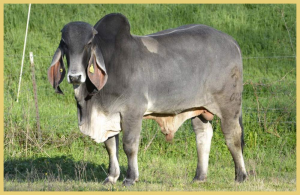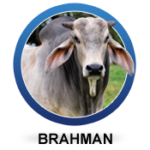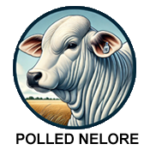INDU BRASIL
Indo-Brazilian (Indubrasil) Cattle: A Unique Zebu Breed from Brazil
The Indo-Brazilian, also known as Indubrasil, is a Zebu (Bos indicus) cattle breed developed in Brazil between 1910 and 1930. This breed was created through selective breeding of Gir, Kankrej, and Ongole cattle, all of which were imported from India.

Origins and History
By 1946, Indo-Brazilian cattle were being exported to the United States, where some sources suggest they played a role in the development of the American Brahman. While the Indo-Brazilian and American Brahman share similar ancestry, they are distinct breeds with notable differences in appearance and build.
Distinctive Characteristics
The Indo-Brazilian breed is recognized for its elegant, tall frame and extremely long, pendulous ears, which hang lower than those of the Brahman.
- Size & Build: Taller and more slender than the Brahman, with a lighter muscle structure.
- Ears: Among the longest of any cattle breed, their ears are wide, pendulous, and hang low.
- Coloration: Typically white to dark gray, sometimes with lighter underbellies.
- Horns: Small, curved, and set wide apart.
- Hump & Skin: Like all Zebu breeds, they have a prominent shoulder hump, loose skin, and a dewlap, which aids in heat dissipation.
Adaptability & Strengths
Like other Bos indicus breeds, Indo-Brazilian cattle thrive in hot, humid climates and are known for their heat tolerance, disease resistance, and ability to withstand harsh tropical conditions.
- Parasite & Disease Resistance: Their thick, loose skin makes them naturally resistant to ticks and insects.
- Heat Tolerance: Their large ears and skin folds help regulate body temperature in hot climates.
- Grazing Efficiency: Indo-Brazilian cattle thrive on low-quality forage, making them ideal for extensive grazing systems.
Uses and Decline in Popularity
Initially, Indo-Brazilian cattle were among the most popular Zebu breeds in Brazil, widely used for both beef and draft purposes. However, by the 1950s, the Nelore breed began to dominate, and today, approximately 90% of Brazilian beef cattle production comes from Nelore cattle. While Indo-Brazilian cattle are still maintained in Brazil, their numbers are significantly lower compared to earlier decades.
Influence on Other Breeds
Despite their decline in numbers, Indo-Brazilian genetics have influenced other breeds:
- Played a possible role in American Brahman development.
- Contributed to Brazilian beef cattle breeding programs, particularly in crossbreeding with Nelore to improve size and adaptability.
The Indo-Brazilian (Indubrasil) breed remains a historically significant Zebu breed, valued for its tropical adaptability, long lifespan, and disease resistance. Although less common today, it continues to be preserved in Brazil and some tropical regions, where its unique build, long ears, and resilience make it a valuable genetic resource.
1
2
3
4
5
6
Copyright © 2025 Bos Indicus International
Contact
P.O. Box 118
Butler, MO 64730
Email: office@bosindicusinternational.org
Phone: 816-738-4179







